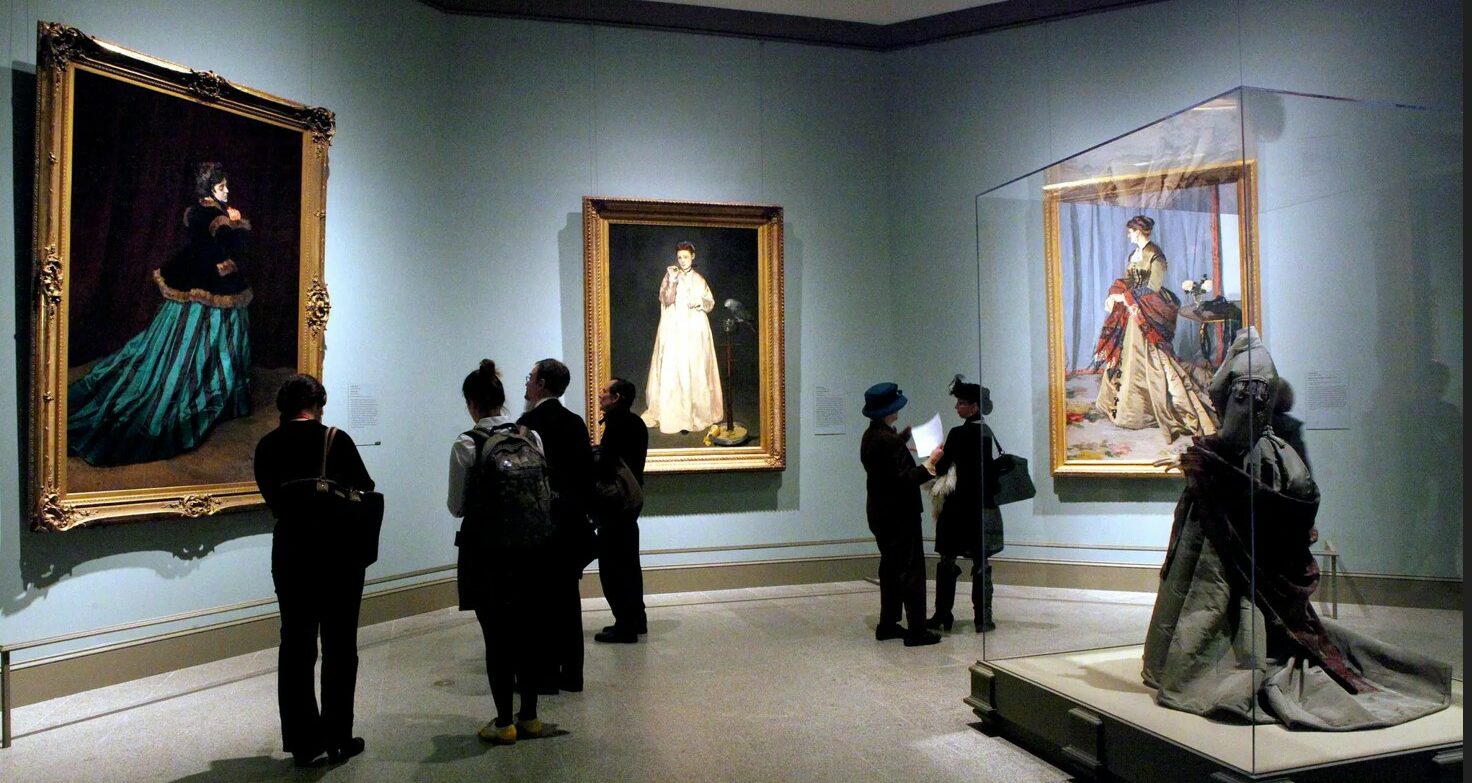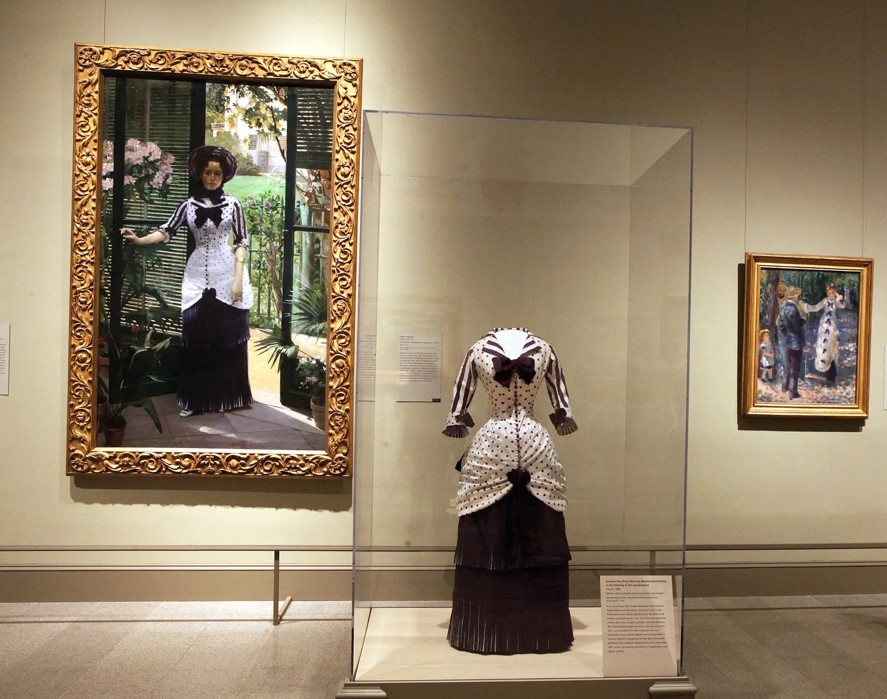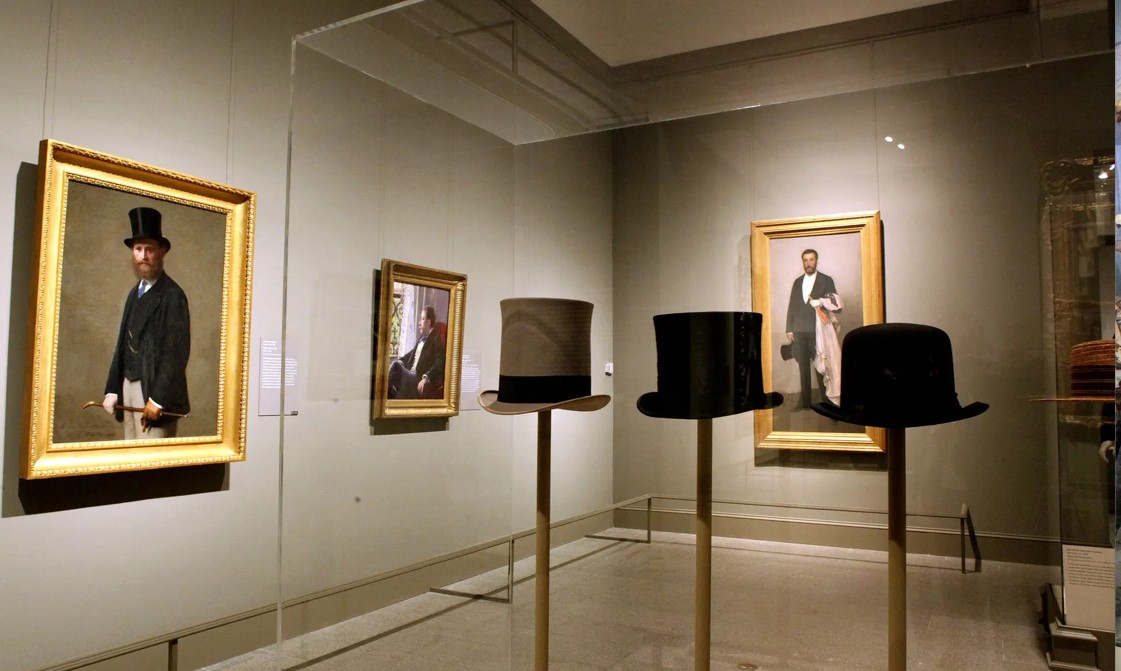The Impressionists Paintings and the Fashions of La Belle Époque are the focus of the splendid exhibit Impressionism, Fashion, and Modernity at the Metropolitan Museum of Art.
The premise of the exhibit is that the Impressionists were in the avant-garde, pushing the envelope of painting in terms of technique, but also in the way they approached portraiture, presenting their subjects in genuinely human ways, and wearing the progressive fashions of the day as symbols of “la modernité.”
Painters like Renoir and Monet, along with their non-impressionist contemporaries such as Manet and Tissot, strove to capture groundbreaking trends in style and society at the end of the Second Empire and throughout the early decades of the Third Republic. With some irony, they now provide a time capsule of a period in history remembered with affectionate nostalgia, La Belle Époque, the French contemporary of the Victorian era.
In addition to the many exquisite paintings, there are numerous dresses from the period, along with glass cases filled with fashion plates of the day and accessories like an ornate feather fan, parasols, dancing slippers, or posh opera glasses overlaid in mother of pearl.
Charlotte Hale is the Met’s Senior Paintings Conservator for nineteenth century art. She said the dresses were so delicate that only two could travel from the Paris version of the exhibit. Others on display are housed at the Met or were borrowed from collections here in the States. But they offer several that are very close to what you see in the artwork.
Hipsters on the Cutting Edge of Fashion
As one enters the galleries, the curators smartly present two dresses and three paintings that encapsulate the central idea of the exhibition quite nicely.
(click photos to enlarge)
The exhibit’s foyer has one glass case containing a day dress with a full, floor length skirt of wide blue and green stripes, said to have been made between 1865 and 1868. The initial painting encountered upon entering the first gallery is La Femme à La Robe Verte which debuted in 1866 and was an early critical success for Claude Monet. The model, his wife Camille, was wearing a virtual twin to the day dress in the case.
The painter had yet to move toward blatant impressionism, but already he was breaking with tradition by having his subject seen from the back, with eyes downcast, in the first act of undressing, untying her bonnet. Another early Monet along the same wall shows the subject from the side, having just set her umbrella on a reception table. Clearly she has entered a private home where she has thrown off her public bearing and can finally be herself.
The moments captured are far from the stiff, formal posing typical of the day, and their clothes are breaking with tradition as well. Parisian society had only recently abandoned the enormous, steel framed crinolines that defined the circus tent silhouette of the 1850s and early 1860s. While dressmakers continued to use the same amount of fabric to costume ladies from the upper classes, it was being pulled back and piled into layers that flowed into the train. Voluminous by later standards, this shift in fashion displayed a more revealing line and shape of the feminine form below the waist, which continued to be accentuated with ever-slimming outlines and the introduction and evolution of the bustle through the 1870s.
But in 1866, Camille’s choice of apparel would have been considered fresh and somewhat daring. Monet and his fellows were presenting their women in the skinny jeans of the day.
The gown on display in the second glass case is quite similar to the one in this second Monet painting. At first I assumed we were seeing an early example of his moving away from realistic forms to softer, rounder expressions of light reflecting off of forms. But then I realized the weighty skirt from the dress was full of padding, so his depiction was actually spot on. The padding under a reflective taupe satin exterior was likely used to add some extra roundness in the absence of a crinoline.
According to Ms. Hale, normally such a dress would have been displayed quite differently, with the skirt spread out to show off its fabric. The costumers who worked on the exhibit spent a great deal of time getting the clothes to drape in much the same way as in the paintings, which reveal how they looked when worn by a human being in real life
An Intimate Perspective
These paintings do well to show off the cut and fall of the apparel, but there is also a voyeuristic quality to many of them, as they are seen from the perspective of one who is looking at a lady in a pretty dress while she is distracted by daily events. In one respect, it puts the viewer at ease to check out her figure and what she has on, while also making one feel like they are stealing a glance while they can get away with it.
Between these first Monets is Jeune dame en 1866 by Édouard Manet. Here the model is staring directly at the viewer.
 But with flat light centered upon her, she seems self-conscious and exposed, like she was absorbed in smelling a small bouquet of flowers, when she glanced up to catch you looking at her. Raising one eyebrow, she reaches for a monocle. It is now her turn to do the observing.
But with flat light centered upon her, she seems self-conscious and exposed, like she was absorbed in smelling a small bouquet of flowers, when she glanced up to catch you looking at her. Raising one eyebrow, she reaches for a monocle. It is now her turn to do the observing.
While not an impressionist painter, Manet’s avant-garde style was in direct rebellion against the traditional portraits of people posed as if acting out some idealized scene from domestic life. Faces set, or barely smiling, his portraits appear like candid snapshots of the real thing – as with the lady intently reading a periodical and unaware that she herself is being thus scrutinized, in Le Journal Illustre 1879-80. Or even the depiction of the sister-in-law he was secretly in love with, as she undresses in Devant la glace, 1876. The effect brings a special sense of intimacy, but also an unsettling feeling of intruding into someone’s private moments.
By comparison, the life scenes painted by Renoir, Tissot, Degas and Cassatt also capture life-like and very personal moments, but usually featuring people blissfully enjoying a nice day, domestic tranquility, or a lively night on the town. Similar subjects but each interpreted differently, through the eye and hand of individual artists working during the same years.
For all the descriptions and photographic examples in this article, nothing compares to seeing these works of art and fashions in person. Only then may one truly appreciate the depth of such masterpieces. Only then can one notice the finest details, or how cleverly Manet painted over the right arm of his sister-in-law before giving her a new one, or how his magazine reader has a face where the sallow mid tones are actually made out of bare canvas, melded with the swaths of oils used for the fleshier crests of her nose and cheeks.
Many Galleries of Vibrant Lives
The various picnics, portraits and street scenes in the exhibit are presented thematically rather than chronologically. There is the room filled with ladies in glowing white summer dresses of gauzy fabric and lace trim, like Tisso’s Les Deux Soeurs (Portraits dans un parc), 1863, and from 1867, Renoir’s Lise – La femme à l’ombrelle, along with a couple of actual dresses on display, so pretty they must elicit squeals of delight from any little girl who visits the exhibit.
This is followed by a room featuring black dresses, including one in Renoir’s masterpiece Mme. Georges Charpentier et ses enfants, which debuted at the general salon of 1879 and earned him important commissions from Madame’s friends.
On display before it is a luxurious black dress festooned with delicate bead work, ornate lace overlay, and a provocative hint of white lace peeking out from the plunging neckline. Thus up close and personal when compared to the distance portrayed in the paintings, one can imagine how a woman would feel so very dressed when wearing such a gown, especially considering the corset required to achieve the slender waist.
Another significant artifact is the striped and polka dot summer day dress that was actually worn by Albert Bartholomé’s wife for his life-size portrait of her, Dans la serre.
It was completed in 1881, a short time before she died, which may explain why the dress was preserved in such fine shape, even if the midnight blue has faded to purple.
But the show is not only about the ladies and their dresses. The well-dressed gentlemen get their own room.
In the words of Charlotte Hale, “The women of this period were the birds of paradise” who were dressed and decorated with lavish color and detail. The men wore conservative suits of somber grays and browns, but were quite stylish after their own fashion. I could easily imagine some of the outfits on display, as if worn by Pasteur, or Zola, or even Sherlock Holmes as they passed one another anonymously on a crowded street in Paris.
And the subdued closet of the French gentleman nicely sets up the incandescent paintings in the room dedicated to the night out on the town. Here the fashionable and well to do are displayed for viewing in all their finery, attracting the unnoticed admirer, as in Mary Cassatt’s In the Loge, 1878. Or, in one of my favorites, Tissot’s Evening (le Ball), 1880, where the wealthy matron smugly checks out the young woman of ambition entering the scene on the arm of a man clearly old enough to be her father.
Fourteen years after Mme. Monet posed in her green stripes, the dress had evolved until the outer layer is barely a decorative shell, with any form provided by the woman beneath or, as in this case, the slender slip of a girl.
A Once in a Lifetime Collection
There are a number of significant works that can only be viewed in New York while the exhibit lasts, including Manet’s La Parisienne, 1874, which rarely leaves its home in Stockholm, and Gustav Caillebotte’s wall-filling Paris Street; Rainy Day, 1877, which is making a rare appearance outside of the Art Institute of Chicago, where the exhibition moves in late May.
The difficulties in packing and transporting such paintings are enormous, as are the crates they are sent in. According to Ms. Hale, each museum has their own methods and at the Met they do not tend to wrap their paintings, because they feel “the less handing the better.” While the paintings themselves are not usually at risk, the ornate frames can be easily damaged.
The value placed on such works of art is staggering. One painting in the exhibit had to travel alone on a plane from Paris, because any single vehicle may not contain more than $100 million worth of art.
“A show of this magnitude cannot be insured; it must be indemnified by the U.S. government.” So the work of conservators like Charlotte Hale starts early in the process and continues up until every item is returned safely to its place of origin.
Although she claims to be very fortunate in her position of employment, it is obvious the Met is lucky to have someone of Hale’s talent and expertise, whose exuberance and love of the art has not tarnished a jot after decades in the profession.
This exhibit is the result of the dedication and labor of the conservators and curators from many different institutions. Anyone in the New York or Chicago areas should make every effort to pay a visit and immerse themselves in the art and fashion that was epitome of modernité during La Belle Époque.
And that is one man’s word on Impressionism, Fashion, and Modernity at the Metropolitan Museum of Art.
[Now closed, many of the important works in this exhibition may be seen in the Met’s general collection. A collaboration between the Met, the Musée d’Orsay, Paris, and the Art Institute of Chicago, the exhibit featured works of the Impressionists’ art, contemporary clothing and historical artifacts from their collections, as well as some on loan from other museums.]


